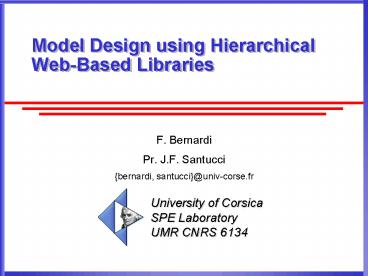Model Design using Hierarchical Web-Based Libraries - PowerPoint PPT Presentation
1 / 26
Title:
Model Design using Hierarchical Web-Based Libraries
Description:
Ease of new models building. Ease of new models validation. Main ... team to work on the same models stored on a server. Basic idea: two possibilities offered ... – PowerPoint PPT presentation
Number of Views:22
Avg rating:3.0/5.0
Title: Model Design using Hierarchical Web-Based Libraries
1
Model Design using Hierarchical Web-Based
Libraries
- F. Bernardi
- Pr. J.F. Santucci
- bernardi, santucci_at_univ-corse.fr
University of Corsica SPE Laboratory UMR CNRS 6134
2
Studied Problem
- Objective of this work to build a generic models
library - Interests
- Reusability of models seen as modeling components
- Ease of new models building
- Ease of new models validation
- Main Requirements
- Ease of use
- Inheritance between models management
- Abstraction Hierarchy between models management
- Remote access capacity
3
Summary
- Basic Notions of MS
- Basics of the Models Library
- Web-Based Architecture
- Screenshots
- Conclusion and Perspectives
4
Summary
- Basic Notions of MS
- Basics of the Models Library
- Web-Based Architecture
- Screenshots
- Conclusion and Perspectives
5
Basic Notions of MS
- Three complementary concepts
- The Multi-Views concept
- Allows a gradual complexity introduction
- Each model of these views represents a particular
part of the global system - Structural view, behavioral view, system view,
- The description hierarchy
- Allows a recursive subsystems hiding
6
Basic Notions of MS
- The abstraction hierarchy
- General problem for modeling choosing a good
level of details - Abstraction level
- Determines the amount of informations contained
in a model - Allows taking efficiently into account the
relevant informations
7
Basic Notions of MS
- The abstraction hierarchy
8
Summary
- Basic Notions of MS
- Basics of the Models Library
- Web-Based Architecture
- Screenshots
- Conclusion and Perspectives
9
Basics of the Models Library
- Software Component
- Software object presenting well-defined
interfaces - Can be personified
- Reusable in different contexts
- Modeling Component
- Software component
- Can be described following different abstraction
levels - Can be context-in or context-out
10
Basics of the Models Library
- Context-in and Context-out models notions
- Context-out model
- Abstraction of a model
- Presents a structure allowing it to be stored in
a library - Context-in model
- Context-out model extracted from its library
- Directly reusable in the environment
11
Basics of the Models Library
- Models Library Object-Oriented architecture
allowing to store and retrieve persistent
context-out models - Structuration mainly based on two paradigms
- Application domains
- Inheritance hierarchy
- Provides the abstraction hierarchy management
12
Basics of the Models Library
- Core of the architecture The Storage Engine
- Build on the model of an Object-Oriented
Database Management System - Uses XML to describe and store models
- Modular and extensible based on the notion of
service - Can use six different element types
13
Basics of the Models Library
- Six elements able to be stored
- Library root object
- Domains DEVS Simulation, VHDL Descriptions,
- Application Domains Science part of the models
- Classification Intermediate Models (CIM) allow a
classification hierarchy between models - Inheritance Intermediate Models (IIM) storage
object allowing the share of properties - Model File storage object (context-out model)
14
Basics of the Models Library
- UML Diagram Links Between Elements
15
Basics of the Models Library
- Service set of functions for the structuring,
the management or the maintenance of a library - Five Main Services
- Name Service
- Classification Service
- Abstraction Hierarchy Service
- Inheritance Service
- Persistence Service
16
Basics of the Models Library
- Abstraction Service
- Based on an Abstraction Matrix
- Manage relative abstraction levels between
context-out models - Inheritance Service
- Not performed directly on context-in models
- Applied on context-out models
- Performed through XML tags
17
Basics of the Models Library
- XML-based Persistence Service
- Context-in to context-out
- Context-out to context-in
18
Summary
- Basic Notions of MS
- Basics of the Models Library
- Web-Based Architecture
- Screenshots
- Conclusion and Perspectives
19
Web-Based Architecture
- Set of tools allowing a design team to work on
the same models stored on a server - Basic idea two possibilities offered for
accessing the storage engine - Using a Web browser
- Directly from the MS environment
20
Web-Based Architecture
- First possibility simple management,
documentation and/or consultation - Second possibility uses APIs for the MS
environment
Web Browser
Network
Application Server
Storage Engine
Server
Network
Application Server
Modeling and Simulation
Storage Engine
Environment
Server
21
Web-Based Architecture
- Implementation Servlets/Applets/Java Web Start
- Technological Choices
- Servlets
- Persistents
- Fasts
- Platform-independents
- Extensible
- Applets
- Very well known
- Ease of use
- Java Web Start
- Fast
- Always up to date
22
Summary
- Basic Notions of MS
- Basics of the Models Library
- Web-Based Architecture
- Screenshots
- Conclusion and Perspectives
23
Screenshots
24
Screenshots
25
Summary
- Basic notions of MS
- Basics of the Models Library
- Web-Based Architecture
- Screenshots
- Conclusion and Perspectives
26
Conclusion and Perspectives
- Main Points and Originalities
- Inheritance Links
- Abstraction Links
- Traduction of DEVS models in XML
- Validation using the JDEVS environment
- Environmental Studies
- CORBA Architecture Study
- Perspectives
- Management of other modeling formalisms
- Improvement of the performances of the storage
engine - Study of the distribution of storage engines on
a network































